List of rhinolophids

Rhinolophidae is one of the twenty families of bats in the mammalian order Chiroptera and part of the microbat suborder. A member of this family is called a rhinolophid or a horseshoe bat. They are named for the shape of their nose-leaf. They are found in Europe, Africa, Asia, and Australia, primarily in forests, savannas, grasslands, and caves, though some species can also be found in deserts or wetlands. They range in size from the Thai horseshoe bat and little Nepalese horseshoe bat, at 3 cm (1 in) plus a 1 cm (0.4 in) tail, to the Maclaud's horseshoe bat, at 10 cm (4 in) plus a 5 cm (2 in) tail. Like all bats, rhinolophids are capable of true and sustained flight, and have wing lengths ranging from 3 cm (1 in) in the Formosan lesser horseshoe bat and little Nepalese horseshoe bat, to 8 cm (3 in) in the great woolly horseshoe bat. They are all insectivorous and eat a variety of insects and spiders.[1] Most rhinolophids do not have population estimates, but the ones that do range from 900 adult individuals to 20,000. Twelve species—the Andaman horseshoe bat, Bornean woolly horseshoe bat, Guinean horseshoe bat, King horseshoe bat, Maclaud's horseshoe bat, Mount Mabu horseshoe bat, Poso horseshoe bat, Ruwenzori horseshoe bat, Timorese horseshoe bat, Willard's horseshoe bat, Yaeyama little horseshoe bat, and Ziama horseshoe bat—are categorized as endangered species, and Hill's horseshoe bat is categorized as critically endangered. These collectively make up almost fifteen percent of the species in the family.
The 92 extant species of Rhinolophidae are all included in a single genus, Rhinolophus. A few extinct prehistoric rhinolophid species have been discovered, though due to ongoing research and discoveries the exact number and categorization is not fixed.[2]
Conventions
[edit]| Conservation status | |
|---|---|
| EX | Extinct (0 species) |
| EW | Extinct in the wild (0 species) |
| CR | Critically Endangered (1 species) |
| EN | Endangered (12 species) |
| VU | Vulnerable (5 species) |
| NT | Near threatened (9 species) |
| LC | Least concern (50 species) |
| Other categories | |
| DD | Data deficient (13 species) |
| NE | Not evaluated (2 species) |
Conservation status codes listed follow the International Union for Conservation of Nature (IUCN) Red List of Threatened Species. Range maps are provided wherever possible; if a range map is not available, a description of the rhinolophid's range is provided. Ranges are based on the IUCN Red List for that species unless otherwise noted.
Classification
[edit]The family Rhinolophidae consists of a single genus, Rhinolophus, containing 92 species.
Rhinolophids
[edit]The following classification is based on the taxonomy described by the reference work Mammal Species of the World (2005), with augmentation by generally accepted proposals made since using molecular phylogenetic analysis, as supported by both the IUCN and the American Society of Mammalogists.[3]
| Common name | Scientific name and subspecies | Range | Size and ecology | IUCN status and estimated population |
|---|---|---|---|---|
| Acuminate horseshoe bat | R. acuminatus Peters, 1871 |
Southeastern Asia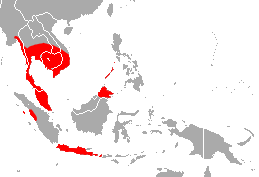
|
Size: 4–6 cm (2 in), plus 1–4 cm (0.4–1.6 in) tail 4–6 cm (2 in) arm/wing length[4] Habitat: Forest and caves[5] |
LC
|
| Adam's horseshoe bat
|
R. adami Aellen & Brosset, 1968 |
Republic of the Congo
|
Size: Unknown length, plus 2–3 cm (1 in) tail 4–6 cm (2 in) arm/wing length[6] Habitat: Forest and caves[7] |
DD
|
| Andaman horseshoe bat | R. cognatus K. Andersen, 1906 |
Andaman Islands
|
Size: About 4 cm (2 in), plus 1–3 cm (0.4–1.2 in) tail 3–5 cm (1–2 in) arm/wing length[4] Habitat: Forest and caves[8] |
EN
|
| Arcuate horseshoe bat | R. arcuatus Peters, 1871 Two subspecies
|
Southeastern Asia
|
Size: 4–7 cm (2–3 in), plus 1–3 cm (0.4–1.2 in) tail 4–6 cm (2 in) arm/wing length[9] Habitat: Forest and caves[10] |
DD
|
| Beddome's horseshoe bat | R. beddomei K. Andersen, 1905 |
Southern India and Sri Lanka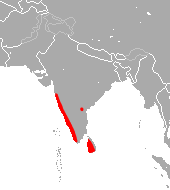
|
Size: 6–8 cm (2–3 in), plus 3–5 cm (1–2 in) tail 5–7 cm (2–3 in) arm/wing length[11] Habitat: Forest and caves[12] |
LC
|
| Big-eared horseshoe bat
|
R. macrotis Blyth, 1844 Five subspecies
|
Eastern and southeastern Asia
|
Size: 4–6 cm (2 in), plus 1–4 cm (0.4–1.6 in) tail 4–6 cm (2 in) arm/wing length[13] Habitat: Forest and caves[14] |
LC
|
| Blasius's horseshoe bat | R. blasii Peters, 1866 |
Scattered Africa, southern Europe, and western Asia
|
Size: 4–6 cm (2 in), plus 2–4 cm (1–2 in) tail 4–6 cm (2 in) arm/wing length[6] Habitat: Forest, savanna, shrubland, caves, and desert[15] |
LC
|
| Blyth's horseshoe bat | R. lepidus Blyth, 1844 Two subspecies
|
Southern and southeastern Asia
|
Size: 3–6 cm (1–2 in), plus 1–3 cm (0.4–1.2 in) tail 3–5 cm (1–2 in) arm/wing length[4] Habitat: Forest and caves[16] |
LC
|
| Bokhara horseshoe bat | R. bocharicus Kastschenko & Akimov, 1917 |
Central Asia
|
Size: 3–5 cm (1–2 in), plus 2–4 cm (1–2 in) tail 4–6 cm (2 in) arm/wing length[13] Habitat: Shrubland, grassland, rocky areas, caves, and desert[17] |
LC
|
| Bornean horseshoe bat | R. borneensis Peters, 1861 |
Southeastern Asia
|
Size: Unknown length, plus 2–3 cm (1 in) tail 4–6 cm (2 in) arm/wing length[4] Habitat: Forest, rocky areas, and caves[18] |
LC
|
| Bornean woolly horseshoe bat
|
R. proconsulis Hill, 1959 |
Borneo | Size: Unknown length 4–6 cm (2 in) arm/wing length[9] Habitat: Forest[19] |
EN
|
| Bourret's horseshoe bat
|
R. paradoxolophus Bourret, 1951 |
Southeastern Asia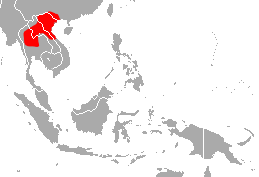
|
Size: 4–6 cm (2 in), plus 1–4 cm (0.4–1.6 in) tail 5–7 cm (2–3 in) arm/wing length[13] Habitat: Forest and caves[20] |
LC
|
| Broad-eared horseshoe bat | R. euryotis Temminck, 1835 |
Southeastern Asia
|
Size: 5–8 cm (2–3 in), plus 1–3 cm (0.4–1.2 in) tail 4–6 cm (2 in) arm/wing length[9] Habitat: Caves and forest[21] |
LC
|
| Bushveld horseshoe bat
|
R. simulator K. Andersen, 1904 |
Eastern and western Africa
|
Size: 3–7 cm (1–3 in), plus 1–3 cm (0.4–1.2 in) tail 3–5 cm (1–2 in) arm/wing length[6] Habitat: Savanna and caves[22] |
LC
|
| Canut's horseshoe bat | R. canuti Thomas & Wroughton, 1909 |
Indonesia
|
Size: 5–7 cm (2–3 in), plus 1–3 cm (0.4–1.2 in) tail 4–6 cm (2 in) arm/wing length[4] Habitat: Forest and caves[23] |
VU
|
| Cape horseshoe bat | R. capensis Lichtenstein, 1823 |
Southern Africa
|
Size: 5–7 cm (2–3 in), plus 2–4 cm (1–2 in) tail 4–6 cm (2 in) arm/wing length[6] Habitat: Shrubland and caves[24] |
LC
|
| Chiewkwee's horseshoe bat
|
R. chiewkweeae Yoshiyuki & Liat, 2005 |
Southeastern Asia | Size: 5–7 cm (2–3 in), plus 1–2 cm (0.4–0.8 in) tail 4–6 cm (2 in) arm/wing length[11] Habitat: Forest[25] |
DD
|
| Chinese rufous horseshoe bat | R. sinicus K. Andersen, 1905 |
Eastern Asia
|
Size: 4–6 cm (2 in), plus 2–3 cm (1 in) tail 4–6 cm (2 in) arm/wing length[9] Habitat: Forest and caves[26] |
LC
|
| Cohen's horseshoe bat
|
R. cohenae Taylor, Stoffberg, Monadjem, Schoeman, Bayliss, & Cotterill, 2012 |
South Africa | Size: 7–9 cm (3–4 in), plus 3–5 cm (1–2 in) tail 6–7 cm (2–3 in) arm/wing length[6] Habitat: Savanna, grassland, rocky areas, and caves[27] |
VU
|
| Convex horseshoe bat
|
R. convexus Csorba, 1997 |
Southeastern Asia
|
Size: Unknown length, plus 1–3 cm (0.4–1.2 in) tail 4–6 cm (2 in) arm/wing length[4] Habitat: Forest[28] |
DD
|
| Creagh's horseshoe bat | R. creaghi Thomas, 1896 |
Southeastern Asia
|
Size: About 5 cm (2 in), plus 1–2 cm (0.4–0.8 in) tail 4–6 cm (2 in) arm/wing length[4] Habitat: Forest and caves[29] |
LC
|
| Croslet horseshoe bat
|
R. coelophyllus Peters, 1867 |
Southeastern Asia
|
Size: 3–5 cm (1–2 in), plus 1–3 cm (0.4–1.2 in) tail 4–6 cm (2 in) arm/wing length[9] Habitat: Forest and caves[30] |
LC
|
| Damara horseshoe bat
|
R. damarensis Roberts, 1946 |
Southern Africa | Size: 6–7 cm (2–3 in), plus 2–4 cm (1–2 in) tail 4–6 cm (2 in) arm/wing length[6] Habitat: Savanna, shrubland, and desert[31] |
LC
|
| Darling's horseshoe bat
|
R. darlingi K. Andersen, 1905 |
Southern Africa
|
Size: 5–7 cm (2–3 in), plus 2–4 cm (1–2 in) tail 4–6 cm (2 in) arm/wing length[6] Habitat: Savanna and caves[32] |
LC
|
| Decken's horseshoe bat | R. deckenii Peters, 1867 |
Eastern Africa
|
Size: 5–7 cm (2–3 in), plus 2–4 cm (1–2 in) tail 4–6 cm (2 in) arm/wing length[6] Habitat: Forest and caves[33] |
NT
|
| Dent's horseshoe bat
|
R. denti Thomas, 1904 |
Southern and western Africa
|
Size: 4–6 cm (2 in), plus 1–3 cm (0.4–1.2 in) tail 3–5 cm (1–2 in) arm/wing length[6] Habitat: Savanna and caves[34] |
LC
|
| Dobson's horseshoe bat
|
R. yunanensis Dobson, 1872 |
Southeastern Asia
|
Size: 5–8 cm (2–3 in), plus 1–3 cm (0.4–1.2 in) tail 4–6 cm (2 in) arm/wing length[11] Habitat: Forest and caves[35] |
LC
|
| Eloquent horseshoe bat | R. eloquens K. Andersen, 1905 |
Eastern Africa
|
Size: 6–8 cm (2–3 in), plus 2–5 cm (1–2 in) tail 5–7 cm (2–3 in) arm/wing length[6] Habitat: Forest, savanna, and caves[36] |
LC
|
| Forest horseshoe bat
|
R. silvestris Aellen, 1959 |
West-central Africa
|
Size: Unknown length, plus 2–4 cm (1–2 in) tail 4–6 cm (2 in) arm/wing length[13] Habitat: Forest and caves[37] |
DD
|
| Formosan lesser horseshoe bat | R. monoceros Temminck, 1835 |
Japan and China | Size: 4–6 cm (2 in), plus 1–3 cm (0.4–1.2 in) tail 3–4 cm (1–2 in) arm/wing length[4] Habitat: Unrecorded |
NE
|
| Formosan woolly horseshoe bat | R. formosae Sanborn, 1939 |
Taiwan
|
Size: 6–9 cm (2–4 in), plus 2–5 cm (1–2 in) tail 5–7 cm (2–3 in) arm/wing length[11] Habitat: Forest and caves[38] |
LC
|
| Geoffroy's horseshoe bat | R. clivosus Cretzschmar, 1828 Two subspecies
|
Africa and Arabian peninsula
|
Size: 4–6 cm (2 in), plus 2–4 cm (1–2 in) tail 4–6 cm (2 in) arm/wing length[13] Habitat: Forest, savanna, shrubland, caves, and desert[39] |
LC
|
| Great woolly horseshoe bat | R. luctus Temminck, 1834 |
Southern and southeastern Asia
|
Size: 7–9 cm (3–4 in), plus 3–6 cm (1–2 in) tail 5–8 cm (2–3 in) arm/wing length[11] Habitat: Caves, rocky areas, and forest[40] |
LC
|
| Greater horseshoe bat | R. ferrumequinum (Schreber, 1774) Seven subspecies
|
Europe, Asia, and northern Africa
|
Size: 5–8 cm (2–3 in), plus 3–5 cm (1–2 in) tail 5–7 cm (2–3 in) arm/wing length[13] Habitat: Forest, shrubland, grassland, and caves[41] |
LC
|
| Guinean horseshoe bat
|
R. guineensis Eisentraut, 1960 |
Western Africa
|
Size: 4–6 cm (2 in), plus 2–3 cm (1 in) tail 4–6 cm (2 in) arm/wing length[6] Habitat: Forest, savanna, grassland, inland wetlands, and caves[42] |
EN
|
| Halcyon horseshoe bat
|
R. alcyone Temminck, 1852 |
Western and central Africa
|
Size: 5–7 cm (2–3 in), plus 1–4 cm (0.4–1.6 in) tail 4–6 cm (2 in) arm/wing length[6] Habitat: Forest, savanna, and caves[43] |
LC
|
| Hildebrandt's horseshoe bat
|
R. hildebrandtii Peters, 1878 |
Eastern Africa
|
Size: 7–9 cm (3–4 in), plus 3–5 cm (1–2 in) tail 6–7 cm (2–3 in) arm/wing length[6] Habitat: Forest, savanna, and caves[44] |
LC
|
| Hill's horseshoe bat
|
R. hilli Aellen, 1973 |
Rwanda
|
Size: About 6 cm (2 in), plus about 3 cm (1 in) tail About 5 cm (2 in) arm/wing length[13] Habitat: Forest and caves[45] |
CR
|
| Hills' horseshoe bat
|
R. hillorum Koopman, 1989 |
Scattered Equatorial Africa
|
Size: 6–8 cm (2–3 in), plus 3–5 cm (1–2 in) tail 4–6 cm (2 in) arm/wing length[13] Habitat: Forest, grassland, and caves[46] |
VU
|
| Imaizumi's horseshoe bat
|
R. imaizumii Hill & Yoshiyuki, 1980 |
Japan | Size: 3–5 cm (1–2 in), plus 1–3 cm (0.4–1.2 in) tail 4–6 cm (2 in) arm/wing length[4] Habitat: Unrecorded |
NE
|
| Indo-Chinese lesser brown horseshoe bat
|
R. microglobosus Csorba and Jenkins, 1998 |
Southeastern Asia
|
Size: 3–6 cm (1–2 in), plus 1–3 cm (0.4–1.2 in) tail 4–6 cm (2 in) arm/wing length[9] Habitat: Caves and forest[47] |
LC
|
| Insular horseshoe bat | R. keyensis Peters, 1871 |
Indonesia
|
Size: 3–5 cm (1–2 in), plus 1–3 cm (0.4–1.2 in) tail 3–5 cm (1–2 in) arm/wing length[4] Habitat: Unknown[48] |
DD
|
| Intermediate horseshoe bat | R. affinis Horsfield, 1823 Nine subspecies
|
Southeastern Asia
|
Size: 4–7 cm (2–3 in), plus 1–4 cm (0.4–1.6 in) tail 4–6 cm (2 in) arm/wing length[9] Habitat: Forest and caves[49] |
LC
|
| King horseshoe bat
|
R. rex Allen, 1923 |
Eastern China
|
Size: 4–6 cm (2 in), plus 1–4 cm (0.4–1.6 in) tail 5–7 cm (2–3 in) arm/wing length[13] Habitat: Forest and caves[50] |
EN
|
| Lander's horseshoe bat | R. landeri Martin, 1837 |
Sub-Saharan Africa
|
Size: 4–6 cm (2 in), plus about 3 cm (1 in) tail 3–5 cm (1–2 in) arm/wing length[6] Habitat: Forest, savanna, shrubland, and caves[51] |
LC
|
| Large rufous horseshoe bat
|
R. rufus Eydoux & Gervais, 1836 |
Philippines
|
Size: 8–10 cm (3–4 in), plus 3–4 cm (1–2 in) tail 6–8 cm (2–3 in) arm/wing length[9] Habitat: Forest and caves[52] |
NT
|
| Large-eared horseshoe bat | R. philippinensis Waterhouse, 1843 |
Southeastern Asia and northeastern Australia
|
Size: 5–7 cm (2–3 in), plus 2–4 cm (1–2 in) tail 4–6 cm (2 in) arm/wing length[13] Habitat: Caves and forest[53] |
LC
|
| Least horseshoe bat | R. pusillus Temminck, 1834 |
Eastern and southeastern Asia
|
Size: 3–5 cm (1–2 in), plus 1–3 cm (0.4–1.2 in) tail 3–5 cm (1–2 in) arm/wing length[4] Habitat: Forest and caves[54] |
LC
|
| Lesser brown horseshoe bat | R. stheno K. Andersen, 1905 |
Southeastern Asia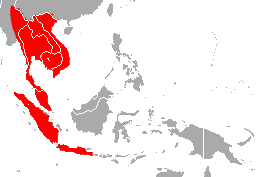
|
Size: 4–6 cm (2 in), plus 1–3 cm (0.4–1.2 in) tail 4–6 cm (2 in) arm/wing length[9] Habitat: Forest[55] |
LC
|
| Lesser horseshoe bat | R. hipposideros (Bechstein, 1800) |
Europe, western Asia, and northern Africa
|
Size: 3–5 cm (1–2 in), plus 2–4 cm (1–2 in) tail 3–5 cm (1–2 in) arm/wing length[9] Habitat: Forest, shrubland, grassland, and caves[56] |
LC
|
| Lesser woolly horseshoe bat | R. sedulus K. Andersen, 1905 |
Southeastern Asia
|
Size: 4–6 cm (2 in), plus 1–3 cm (0.4–1.2 in) tail 3–5 cm (1–2 in) arm/wing length[9] Habitat: Forest and caves[57] |
NT
|
| Little Japanese horseshoe bat | R. cornutus Temminck, 1834 Three subspecies
|
Japan and China | Size: 3–6 cm (1–2 in), plus 1–3 cm (0.4–1.2 in) tail 3–5 cm (1–2 in) arm/wing length[4] Habitat: Forest[58] |
NT
|
| Little Nepalese horseshoe bat
|
R. subbadius Blyth, 1844 |
Eastern Asia
|
Size: 3–4 cm (1–2 in), plus 1–2 cm (0.4–0.8 in) tail 3–4 cm (1–2 in) arm/wing length[4] Habitat: Forest and caves[59] |
LC
|
| Maclaud's horseshoe bat
|
R. maclaudi Pousargues, 1897 |
Western Africa
|
Size: 7–10 cm (3–4 in), plus 3–5 cm (1–2 in) tail 6–7 cm (2–3 in) arm/wing length[13] Habitat: Savanna and caves[60] |
EN
|
| Madura horseshoe bat
|
R. madurensis K. Andersen, 1918 |
Indonesia
|
Size: Unknown length 3–5 cm (1–2 in) arm/wing length[4] Habitat: Forest and caves[61] |
VU
|
| Maendeleo horseshoe bat
|
R. maendeleo Kock, Csorba, & Howell, 2000 |
Eastern Africa
|
Size: 4–6 cm (2 in), plus 2–3 cm (1 in) tail 4–6 cm (2 in) arm/wing length[6] Habitat: Forest and caves[62] |
DD
|
| Malayan horseshoe bat
|
R. malayanus Bonhote, 1903 |
Southeastern Asia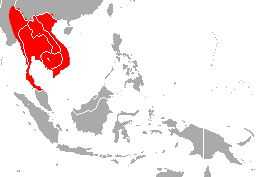
|
Size: 3–5 cm (1–2 in), plus 1–3 cm (0.4–1.2 in) tail 3–5 cm (1–2 in) arm/wing length[4] Habitat: Forest and caves[63] |
LC
|
| Marshall's horseshoe bat
|
R. marshalli Thonglongya, 1973 |
Southeastern Asia
|
Size: 4–6 cm (2 in), plus 1–3 cm (0.4–1.2 in) tail 3–5 cm (1–2 in) arm/wing length[13] Habitat: Forest, rocky areas, and caves[64] |
LC
|
| McIntyre's horseshoe bat
|
R. mcintyrei Hill & Schlitter, 1982 |
Papua New Guinea | Size: 4–7 cm (2–3 in), plus 1–3 cm (0.4–1.2 in) tail 4–6 cm (2 in) arm/wing length[9] Habitat: Forest[65] |
DD
|
| Mediterranean horseshoe bat | R. euryale Blasius, 1853 |
Europe, western Asia, and northern Africa
|
Size: 4–6 cm (2 in), plus 2–3 cm (1 in) tail 4–6 cm (2 in) arm/wing length[6] Habitat: Forest, shrubland, and caves[66] |
NT
|
| Mehely's horseshoe bat | R. mehelyi Matschie, 1901 |
Southern Europe, western Asia, and northern Africa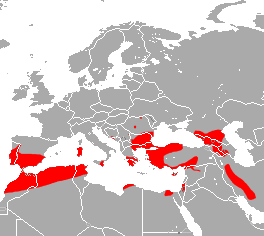
|
Size: 4–7 cm (2–3 in), plus 2–4 cm (1–2 in) tail 2–4 cm (1–2 in) arm/wing length[6] Habitat: Shrubland and caves[67] |
VU
|
| Mitred horseshoe bat | R. mitratus Blyth, 1844 |
Eastern India
|
Size: About 7 cm (3 in), plus about 3 cm (1 in) tail About 6 cm (2 in) arm/wing length[11] Habitat: Unknown[68] |
DD
|
| Mount Mabu horseshoe bat
|
R. mabuensis Taylor, Stoffberg, Monadjem, Schoeman, Bayliss, & Cotterill, 2012 |
Mozambique | Size: 7–9 cm (3–4 in), plus 3–5 cm (1–2 in) tail 6–7 cm (2–3 in) arm/wing length[6] Habitat: Caves and forest[69] |
EN
|
| Mozambican horseshoe bat | R. mossambicus Taylor, Stoffberg, Monadjem, Schoeman, Bayliss, & Cotterill, 2012 |
Southeastern Africa | Size: Unknown length 6–7 cm (2–3 in) arm/wing length[6] Habitat: Forest, savanna, and caves[70] |
LC
|
| Neriad horseshoe bat
|
R. nereis K. Andersen, 1905 |
Siantan Island in Indonesia
|
Size: Unknown length, plus about 2 cm (1 in) tail About 4 cm (2 in) arm/wing length[4] Habitat: Unknown[71] |
DD
|
| Osgood's horseshoe bat
|
R. osgoodi Sanborn, 1939 |
Southern China
|
Size: Unknown length, plus 1–3 cm (0.4–1.2 in) tail 4–6 cm (2 in) arm/wing length[13] Habitat: Caves[72] |
LC
|
| Pearson's horseshoe bat | R. pearsonii Horsfield, 1851 |
Eastern and southeastern Asia
|
Size: 5–7 cm (2–3 in), plus 1–3 cm (0.4–1.2 in) tail 4–6 cm (2 in) arm/wing length[11] Habitat: Forest and caves[73] |
LC
|
| Peninsular horseshoe bat
|
R. robinsoni K. Andersen, 1918 |
Malaysia and Thailand
|
Size: 4–6 cm (2 in), plus 1–3 cm (0.4–1.2 in) tail 4–6 cm (2 in) arm/wing length[4] Habitat: Rocky areas and forest[74] |
NT
|
| Philippine forest horseshoe bat
|
R. inops K. Andersen, 1905 |
Philippines
|
Size: 5–7 cm (2–3 in), plus 1–3 cm (0.4–1.2 in) tail 4–6 cm (2 in) arm/wing length[9] Habitat: Forest[75] |
LC
|
| Poso horseshoe bat
|
R. belligerator Patrick, McCulloch, & Ruedas, 2013 |
Sulawesi Island in Indonesia | Size: 5–7 cm (2–3 in), plus 1–3 cm (0.4–1.2 in) tail 4–6 cm (2 in) arm/wing length[9] Habitat: Unknown[76] |
EN
|
| Rufous horseshoe bat | R. rouxii Temminck, 1835 |
Southern Asia
|
Size: 4–6 cm (2 in), plus 2–4 cm (1–2 in) tail 4–6 cm (2 in) arm/wing length[9] Habitat: Forest and caves[77] |
LC
|
| Ruwenzori horseshoe bat
|
R. ruwenzorii Hill, 1942 |
Central Africa
|
Size: 5–8 cm (2–3 in), plus 2–4 cm (1–2 in) tail 5–7 cm (2–3 in) arm/wing length[13] Habitat: Forest, shrubland, grassland, and caves[78] |
EN
|
| Rüppell's horseshoe bat | R. fumigatus Rüppell, 1842 |
Sub-Saharan Africa
|
Size: 4–8 cm (2–3 in), plus 2–4 cm (1–2 in) tail 4–6 cm (2 in) arm/wing length[6] Habitat: Forest, savanna, and caves[79] |
LC
|
| Sakeji horseshoe bat
|
R. sakejiensis Cotterill, 2002 |
Zambia
|
Size: 4–6 cm (2 in), plus 2–4 cm (1–2 in) tail 4–6 cm (2 in) arm/wing length[13] Habitat: Savanna[80] |
DD
|
| Shamel's horseshoe bat
|
R. shameli Tate, 1943 |
Southeastern Asia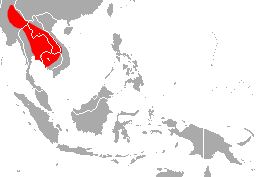
|
Size: 4–6 cm (2 in), plus 1–3 cm (0.4–1.2 in) tail 4–6 cm (2 in) arm/wing length[9] Habitat: Forest and caves[81] |
LC
|
| Shortridge's horseshoe bat
|
R. shortridgei K. Andersen, 1918 |
Eastern Asia
|
Size: 4–6 cm (2 in), plus 1–3 cm (0.4–1.2 in) tail 3–5 cm (1–2 in) arm/wing length[4] Habitat: Forest[82] |
DD
|
| Small rufous horseshoe bat
|
R. subrufus K. Andersen, 1905 |
Philippines
|
Size: 6–7 cm (2–3 in), plus 2–3 cm (1 in) tail 4–6 cm (2 in) arm/wing length[9] Habitat: Forest and caves[83] |
DD
|
| Smaller horseshoe bat | R. megaphyllus Gray, 1834 |
Eastern Australia and Papua New Guinea
|
Size: 4–6 cm (2 in), plus 1–3 cm (0.4–1.2 in) tail 4–6 cm (2 in) arm/wing length[4] Habitat: Caves and forest[84] |
LC
|
| Smithers's horseshoe bat | R. smithersi Taylor, Stoffberg, Monadjem, Schoeman, Bayliss, & Cotterill, 2012 |
Southern Africa | Size: 7–9 cm (3–4 in), plus 3–5 cm (1–2 in) tail 6–7 cm (2–3 in) arm/wing length[6] Habitat: Savanna, shrubland, inland wetlands, and caves[85] |
NT
|
| Sulawesi broad-eared horseshoe bat
|
R. tatar Bergmans & Rozendaal, 1982 |
Sulawesi Island in Indonesia | Size: 5–7 cm (2–3 in), plus 1–3 cm (0.4–1.2 in) tail 4–6 cm (2 in) arm/wing length[9] Habitat: Forest[86] |
LC
|
| Sulawesi horseshoe bat | R. celebensis K. Andersen, 1905 |
Indonesia
|
Size: 4–6 cm (2 in), plus 1–3 cm (0.4–1.2 in) tail 3–5 cm (1–2 in) arm/wing length[4] Habitat: Forest and caves[87] |
LC
|
| Swinny's horseshoe bat
|
R. swinnyi Gough, 1908 |
Southern Africa
|
Size: 4–6 cm (2 in), plus 1–3 cm (0.4–1.2 in) tail 4–6 cm (2 in) arm/wing length[6] Habitat: Forest, savanna, and caves[88] |
LC
|
| Thai horseshoe bat
|
R. siamensis Gyldenstolpe, 1917 |
Southeastern Asia
|
Size: 3–4 cm (1–2 in), plus 1–3 cm (0.4–1.2 in) tail 3–5 cm (1–2 in) arm/wing length[13] Habitat: Forest and caves[89] |
LC
|
| Thailand horseshoe bat
|
R. thailandensis Wu, Harada, & Motokawa, 2009 |
Northern Thailand
|
Size: 6–8 cm (2–3 in), plus 1–3 cm (0.4–1.2 in) tail 5–7 cm (2–3 in) arm/wing length[11] Habitat: Forest and caves[90] |
LC
|
| Thomas's horseshoe bat | R. thomasi K. Andersen, 1905 |
Southeastern Asia
|
Size: 4–6 cm (2 in), plus 1–3 cm (0.4–1.2 in) tail 4–6 cm (2 in) arm/wing length[9] Habitat: Caves[91] |
LC
|
| Timorese horseshoe bat
|
R. montanus Goodwin, 1979 |
East Timor
|
Size: 4–6 cm (2 in), plus 2–4 cm (1–2 in) tail 4–6 cm (2 in) arm/wing length[13] Habitat: Caves and unknown[92] |
EN
|
| Trefoil horseshoe bat | R. trifoliatus Temminck, 1834 |
Southeastern Asia
|
Size: 5–7 cm (2–3 in), plus 2–4 cm (1–2 in) tail 4–6 cm (2 in) arm/wing length[9] Habitat: Forest[93] |
NT
|
| Wedge-sellaed horseshoe bat
|
R. xinanzhongguoensis Zhou, Guillén-Servent, Lim, Eger, Wang, & Jiang, 2009 |
China | Size: 5–7 cm (2–3 in), plus 3–4 cm (1–2 in) tail 4–6 cm (2 in) arm/wing length[13] Habitat: Forest[94] |
NT
|
| Willard's horseshoe bat
|
R. willardi Peterhans & Fahr, 2013 |
Democratic Republic of the Congo | Size: 6–8 cm (2–3 in), plus 2–3 cm (1 in) tail 4–6 cm (2 in) arm/wing length[13] Habitat: Forest and caves[95] |
EN
|
| Yaeyama little horseshoe bat
|
R. perditus K. Andersen, 1918 |
Yaeyama Islands in Japan | Size: 3–5 cm (1–2 in), plus 1–3 cm (0.4–1.2 in) tail 4–6 cm (2 in) arm/wing length[4] Habitat: Caves, inland wetlands, and forest[96] |
EN
|
| Yellow-faced horseshoe bat
|
R. virgo K. Andersen, 1905 |
Philippines
|
Size: 4–6 cm (2 in), plus 1–3 cm (0.4–1.2 in) tail 3–5 cm (1–2 in) arm/wing length[4] Habitat: Caves and forest[97] |
LC
|
| Ziama horseshoe bat
|
R. ziama Fahr, Vierhaus, Hütterer, & Kock, 2002 |
Western Africa
|
Size: 7–8 cm (3 in), plus 3–4 cm (1–2 in) tail About 6 cm (2 in) arm/wing length[13] Habitat: Caves and forest[98] |
EN
|
References
[edit]- ^ Nowak, p. 109
- ^ "Fossilworks: Rhinolophidae". Paleobiology Database. University of Wisconsin–Madison. Archived from the original on October 9, 2022. Retrieved July 21, 2024.
- ^ Wilson, Reeder, pp. 350-364
- ^ a b c d e f g h i j k l m n o p q r s t u v Chernasky; Motis; Burgin, pp. 479–480
- ^ a b Thong, V. D.; Thanh, H. T.; Soisook, P.; Csorba, G. (2019). "Rhinolophus acuminatus". IUCN Red List of Threatened Species. 2019: e.T19520A21974227. doi:10.2305/IUCN.UK.2019-3.RLTS.T19520A21974227.en.
- ^ a b c d e f g h i j k l m n o p q r s t u v Chernasky; Motis; Burgin, pp. 475–476
- ^ a b Jacobs, D.; Cotterill, F. P. D.; Taylor, P. J. (2019). "Rhinolophus adami". IUCN Red List of Threatened Species. 2019: e.T19521A21982298. doi:10.2305/IUCN.UK.2019-3.RLTS.T19521A21982298.en.
- ^ a b Aul, B.; Chakravarty, R. (2016). "Rhinolophus cognatus". IUCN Red List of Threatened Species. 2016: e.T19533A21981807. doi:10.2305/IUCN.UK.2016-2.RLTS.T19533A21981807.en.
- ^ a b c d e f g h i j k l m n o p q r s t Chernasky; Motis; Burgin, pp. 481–482
- ^ a b Alviola, P. A.; Duya, M. R. (2021). "Rhinolophus arcuatus". IUCN Red List of Threatened Species. 2021: e.T84372137A21983371. doi:10.2305/IUCN.UK.2021-3.RLTS.T84372137A21983371.en.
- ^ a b c d e f g h Chernasky; Motis; Burgin, p. 483
- ^ a b Srinivasulu, B.; Srinivasulu, C. (2019). "Rhinolophus beddomei". IUCN Red List of Threatened Species. 2019: e.T40023A22061859. doi:10.2305/IUCN.UK.2019-3.RLTS.T40023A22061859.en.
- ^ a b c d e f g h i j k l m n o p q r s t Chernasky; Motis; Burgin, pp. 477–478
- ^ a b Tu, V.; Csorba, G.; Srinivasulu, C. (2019). "Rhinolophus macrotis". IUCN Red List of Threatened Species. 2019: e.T19550A21978583. doi:10.2305/IUCN.UK.2019-3.RLTS.T19550A21978583.en.
- ^ a b Taylor, P. (2016). "Rhinolophus blasii". IUCN Red List of Threatened Species. 2016: e.T19515A21972073. doi:10.2305/IUCN.UK.2016-2.RLTS.T19515A21972073.en.
- ^ a b Srinivasulu, B.; Csorba, G.; Srinivasulu, C. (2019). "Rhinolophus lepidus". IUCN Red List of Threatened Species. 2019: e.T19547A21977419. doi:10.2305/IUCN.UK.2019-3.RLTS.T19547A21977419.en.
- ^ a b Benda, P.; Kruskop, S. V.; Srinivasulu, B. (2019). "Rhinolophus bocharicus". IUCN Red List of Threatened Species. 2019: e.T19526A21983564. doi:10.2305/IUCN.UK.2019-3.RLTS.T19526A21983564.en.
- ^ a b Jayaraj, V. K. (2020). "Rhinolophus borneensis". IUCN Red List of Threatened Species. 2020: e.T19527A21982599. doi:10.2305/IUCN.UK.2020-2.RLTS.T19527A21982599.en.
- ^ a b Patrick, L.; Ruedas, L. (2017). "Rhinolophus proconsulis". IUCN Red List of Threatened Species. 2017: e.T84372306A84372372. doi:10.2305/IUCN.UK.2017-2.RLTS.T84372306A84372372.en.
- ^ a b Bates, P.; Bumrungsri, S.; Csorba, G. (2008). "Rhinolophus paradoxolophus". IUCN Red List of Threatened Species. 2008: e.T19558A8976934. doi:10.2305/IUCN.UK.2008.RLTS.T19558A8976934.en.
- ^ a b Armstrong, K. N.; Aplin, K. (2021) [amended version of 2017 assessment]. "Rhinolophus euryotis". IUCN Red List of Threatened Species. 2021: e.T84372418A209537830. doi:10.2305/IUCN.UK.2021-3.RLTS.T84372418A209537830.en.
- ^ a b Monadjem, A.; Taylor, P. J.; Jacobs, D.; Cotterill, F. (2017). "Rhinolophus simulator". IUCN Red List of Threatened Species. 2017: e.T19568A21994351. doi:10.2305/IUCN.UK.2017-2.RLTS.T19568A21994351.en.
- ^ a b Waldien, D. L.; Wiantoro, S. (2021). "Rhinolophus canuti". IUCN Red List of Threatened Species. 2021: e.T19528A21982962. doi:10.2305/IUCN.UK.2021-2.RLTS.T19528A21982962.en.
- ^ a b Jacobs, D.; Monadjem, A. (2017). "Rhinolophus capensis". IUCN Red List of Threatened Species. 2017: e.T19529A21980883. doi:10.2305/IUCN.UK.2017-2.RLTS.T19529A21980883.en.
- ^ a b Waldien, D. L. (2020). "Rhinolophus chiewkweeae". IUCN Red List of Threatened Species. 2020: e.T84372474A84372528. doi:10.2305/IUCN.UK.2020-2.RLTS.T84372474A84372528.en.
- ^ a b Sun, K. (2019). "Rhinolophus sinicus". IUCN Red List of Threatened Species. 2019: e.T41529A22005184. doi:10.2305/IUCN.UK.2019-3.RLTS.T41529A22005184.en.
- ^ a b Cohen, L.; Taylor, P.; Jacobs, D.; Kearney, T.; MacEwan, K.; Monadjem, A.; Richards, L. R.; Schoeman, C.; Sethusa, T. (2017). "Rhinolophus cohenae". IUCN Red List of Threatened Species. 2017: e.T64587154A64587542. doi:10.2305/IUCN.UK.2017-2.RLTS.T64587154A64587542.en.
- ^ a b Csorba, G.; Bumrungsri, S.; Francis, C; Görföl, T.; Bates, P. J. J. (2016). "Rhinolophus convexus". IUCN Red List of Threatened Species. 2016: e.T40037A22060825. doi:10.2305/IUCN.UK.2016-2.RLTS.T40037A22060825.en.
- ^ a b Jayaraj, V. K. (2020). "Rhinolophus creaghi". IUCN Red List of Threatened Species. 2020: e.T19535A21981495. doi:10.2305/IUCN.UK.2020-2.RLTS.T19535A21981495.en.
- ^ a b Furey, N.; Bates, P. J. J.; Bumrungsri, S.; Csorba, G. (2020). "Rhinolophus coelophyllus". IUCN Red List of Threatened Species. 2020: e.T19532A21980746. doi:10.2305/IUCN.UK.2020-3.RLTS.T19532A21980746.en.
- ^ a b Monadjem, A.; Jacobs, D.; Taylor, P.; Cohen, L.; MacEwan, K.; Richards, L. R.; Sethusa, T. (2017). "Rhinolophus damarensis". IUCN Red List of Threatened Species. 2017: e.T67369846A67369914. doi:10.2305/IUCN.UK.2017-2.RLTS.T67369846A67369914.en.
- ^ a b Monadjem, A.; Taylor, P. J.; Jacobs, D.; Cotterill, F. (2017). "Rhinolophus darlingi". IUCN Red List of Threatened Species. 2017: e.T67369483A21981665. doi:10.2305/IUCN.UK.2017-2.RLTS.T67369483A21981665.en.
- ^ a b Shapiro, J.; Cooper-Bohannon, R.; Jacobs, D.; Cotterill, F. P. D.; Taylor, P. J. (2020). "Rhinolophus deckenii". IUCN Red List of Threatened Species. 2020: e.T19537A21979537. doi:10.2305/IUCN.UK.2020-2.RLTS.T19537A21979537.en.
- ^ a b Monadjem, A.; Griffin, M.; Cotterill, F.; Jacobs, D.; Taylor, P. J. (2017). "Rhinolophus denti". IUCN Red List of Threatened Species. 2017: e.T19538A21979433. doi:10.2305/IUCN.UK.2017-2.RLTS.T19538A21979433.en.
- ^ a b Bates, P. J. J.; Bumrungsri, S.; Csorba, G.; Molur, S.; Srinivasulu, C.; Mao, X. G. (2019). "Rhinolophus yunanensis". IUCN Red List of Threatened Species. 2019: e.T19576A21991423. doi:10.2305/IUCN.UK.2019-3.RLTS.T19576A21991423.en.
- ^ a b Monadjem, A.; Taylor, P. J.; Jacobs, D.; Cotterill, F. (2017). "Rhinolophus eloquens". IUCN Red List of Threatened Species. 2017: e.T19539A21979320. doi:10.2305/IUCN.UK.2017-2.RLTS.T19539A21979320.en.
- ^ a b Cotterill, F. P. D. (2019). "Rhinolophus silvestris". IUCN Red List of Threatened Species. 2019: e.T19567A21994523. doi:10.2305/IUCN.UK.2019-3.RLTS.T19567A21994523.en.
- ^ a b Huang, J. C. -C.; Lee, Y.; Ho, Y.; Chou, C.; Cheng, H.-C. (2019). "Rhinolophus formosae". IUCN Red List of Threatened Species. 2019: e.T136644A21989870. doi:10.2305/IUCN.UK.2019-3.RLTS.T136644A21989870.en.
- ^ a b Monadjem, A.; Taylor, P. J.; Jacobs, D.; Kock, D.; Amr, Z. S. S.; Cotterill, F. (2017). "Rhinolophus clivosus". IUCN Red List of Threatened Species. 2017: e.T19531A21980500. doi:10.2305/IUCN.UK.2017-2.RLTS.T19531A21980500.en.
- ^ a b Thong, V. D.; Thanh, H. T.; Soisook, P.; Csorba, G. (2019). "Rhinolophus luctus". IUCN Red List of Threatened Species. 2019: e.T19548A21977086. doi:10.2305/IUCN.UK.2019-3.RLTS.T19548A21977086.en.
- ^ a b Piraccini, R. (2016). "Rhinolophus ferrumequinum". IUCN Red List of Threatened Species. 2016: e.T19517A21973253. doi:10.2305/IUCN.UK.2016-2.RLTS.T19517A21973253.en.
- ^ a b Shapiro, J.; Cooper-Bohannon, R. (2020). "Rhinolophus guineensis". IUCN Red List of Threatened Species. 2020: e.T19542A21980043. doi:10.2305/IUCN.UK.2020-2.RLTS.T19542A21980043.en.
- ^ a b Monadjem, A.; Taylor, P. J.; Jacobs, D.; Cotterill, F. (2017). "Rhinolophus alcyone". IUCN Red List of Threatened Species. 2017: e.T19523A21981963. doi:10.2305/IUCN.UK.2017-2.RLTS.T19523A21981963.en.
- ^ a b Monadjem, A.; Jacobs, D. (2017). "Rhinolophus hildebrandtii". IUCN Red List of Threatened Species. 2017: e.T64586080A21979893. doi:10.2305/IUCN.UK.2017-2.RLTS.T64586080A21979893.en.
- ^ a b Webala, P.; Flanders, J.; Frick, W. F.; Fahr, J. (2021). "Rhinolophus hilli". IUCN Red List of Threatened Species. 2021: e.T44781A203829053. doi:10.2305/IUCN.UK.2021-3.RLTS.T44781A203829053.en.
- ^ a b Obitte, B.; Tanshi, I. (2022). "Rhinolophus hillorum". IUCN Red List of Threatened Species. 2022: e.T44782A203829273. doi:10.2305/IUCN.UK.2022-2.RLTS.T44782A203829273.en.
- ^ a b Soisook, P. (2017). "Rhinolophus microglobosus". IUCN Red List of Threatened Species. 2017: e.T84384558A84384597. doi:10.2305/IUCN.UK.2017-2.RLTS.T84384558A84384597.en.
- ^ a b Csorba, G.; Bates, P. J. J. (2016). "Rhinolophus keyensis". IUCN Red List of Threatened Species. 2016: e.T19577A21992519. doi:10.2305/IUCN.UK.2016-2.RLTS.T19577A21992519.en.
- ^ a b Furey, N.; Walston, J.; Kingston, T.; Hutson, A. M. (2020). "Rhinolophus affinis". IUCN Red List of Threatened Species. 2020: e.T19522A21982358. doi:10.2305/IUCN.UK.2020-3.RLTS.T19522A21982358.en.
- ^ a b Sun, K. (2020). "Rhinolophus rex". IUCN Red List of Threatened Species. 2020: e.T19562A21994639. doi:10.2305/IUCN.UK.2020-2.RLTS.T19562A21994639.en.
- ^ a b Monadjem, A.; Taylor, P. J.; Jacobs, D.; Cotterill, F. (2017). "Rhinolophus landeri". IUCN Red List of Threatened Species. 2017: e.T19546A21977797. doi:10.2305/IUCN.UK.2017-2.RLTS.T19546A21977797.en.
- ^ a b Alviola, P. A.; Sedlock, J.; Alvarez, J.; Fidelino, J.; Gatan-Balbas, M.; Pedregosa, M.; Veluz, M. J.; Tanalgo, K.; Cielo, K. L. S.; Garcia, J. J. L.; Cacho, M. A.; Ong, P.; Rosell-Ambal, R. G. B.; Tabaranza, B.; Heaney, L. (2019). "Rhinolophus rufus". IUCN Red List of Threatened Species. 2019: e.T19564A21995212. doi:10.2305/IUCN.UK.2019-3.RLTS.T19564A21995212.en.
- ^ a b Armstrong, K. N. (2021). "Rhinolophus philippinensis". IUCN Red List of Threatened Species. 2021: e.T19560A21992817. doi:10.2305/IUCN.UK.2021-3.RLTS.T19560A21992817.en.
- ^ a b Fukui, D. (2019). "Rhinolophus pusillus". IUCN Red List of Threatened Species. 2019: e.T85707059A21994916. doi:10.2305/IUCN.UK.2019-3.RLTS.T85707059A21994916.en.
- ^ a b Bates, P. J. J.; Bumrungsri, S.; Csorba, G.; Soisook, P. (2019). "Rhinolophus stheno". IUCN Red List of Threatened Species. 2019: e.T84383122A21991664. doi:10.2305/IUCN.UK.2019-3.RLTS.T84383122A21991664.en.
- ^ a b Taylor, P. (2016). "Rhinolophus hipposideros". IUCN Red List of Threatened Species. 2016: e.T19518A21972794. doi:10.2305/IUCN.UK.2016-2.RLTS.T19518A21972794.en.
- ^ a b Jayaraj, V. K. (2020). "Rhinolophus sedulus". IUCN Red List of Threatened Species. 2020: e.T19565A21994153. doi:10.2305/IUCN.UK.2020-2.RLTS.T19565A21994153.en.
- ^ a b Chiroptera Specialist Group (2024). "Rhinolophus cornutus". IUCN Red List of Threatened Species. 1996: e.T19534A8957242. doi:10.2305/IUCN.UK.1996.RLTS.T19534A8957242.en.
- ^ a b Srinivasulu, B.; Srinivasulu, C. (2019). "Rhinolophus subbadius". IUCN Red List of Threatened Species. 2019: e.T19570A21991844. doi:10.2305/IUCN.UK.2019-3.RLTS.T19570A21991844.en.
- ^ a b Shapiro, J.; Cooper-Bohannon, R.; Fahr, J. (2019). "Rhinolophus maclaudi". IUCN Red List of Threatened Species. 2019: e.T19549A21978925. doi:10.2305/IUCN.UK.2019-3.RLTS.T19549A21978925.en.
- ^ a b Csorba, G.; Kingston, T.; Hutson, A. M. (2016). "Rhinolophus madurensis". IUCN Red List of Threatened Species. 2016: e.T136410A22016850. doi:10.2305/IUCN.UK.2016-2.RLTS.T136410A22016850.en.
- ^ a b Cooper-Bohannon, R. (2020). "Rhinolophus maendeleo". IUCN Red List of Threatened Species. 2020: e.T44783A22067758. doi:10.2305/IUCN.UK.2020-2.RLTS.T44783A22067758.en.
- ^ a b Bates, P.; Bumrungsri, S.; Csorba, G.; Soisook, P. (2019). "Rhinolophus malayanus". IUCN Red List of Threatened Species. 2019: e.T19551A21978424. doi:10.2305/IUCN.UK.2019-3.RLTS.T19551A21978424.en.
- ^ a b Thong, V. D.; Thanh, H. T.; Soisook, P.; Bates, P. J. J.; Csorba, G. (2019). "Rhinolophus marshalli". IUCN Red List of Threatened Species. 2019: e.T19552A21978274. doi:10.2305/IUCN.UK.2019-3.RLTS.T19552A21978274.en.
- ^ a b Patrick, L.; Ruedas, L. (2017). "Rhinolophus mcintyrei". IUCN Red List of Threatened Species. 2017: e.T84372245A84372277. doi:10.2305/IUCN.UK.2017-2.RLTS.T84372245A84372277.en.
- ^ a b Juste, J.; Alcaldé, J. (2016). "Rhinolophus euryale". IUCN Red List of Threatened Species. 2016: e.T19516A21971185. doi:10.2305/IUCN.UK.2016-2.RLTS.T19516A21971185.en.
- ^ a b Alcaldé, J.; Benda, P.; Juste, J. (2016). "Rhinolophus mehelyi". IUCN Red List of Threatened Species. 2016: e.T19519A21974380. doi:10.2305/IUCN.UK.2016-2.RLTS.T19519A21974380.en.
- ^ a b Csorba, G.; Molur, S.; Srinivasulu, C. (2016). "Rhinolophus mitratus". IUCN Red List of Threatened Species. 2016: e.T19554A21993304. doi:10.2305/IUCN.UK.2016-2.RLTS.T19554A21993304.en.
- ^ a b Taylor, P. (2019). "Rhinolophus mabuensis". IUCN Red List of Threatened Species. 2019: e.T64588047A64588304. doi:10.2305/IUCN.UK.2019-1.RLTS.T64588047A64588304.en.
- ^ a b Shoeman, C. (2017). "Rhinolophus mossambicus". IUCN Red List of Threatened Species. 2017: e.T64589126A64589338. doi:10.2305/IUCN.UK.2017-2.RLTS.T64589126A64589338.en.
- ^ a b Bates, P.; Bumrungsri, S.; Walston, J.; Csorba, G. (2016). "Rhinolophus nereis". IUCN Red List of Threatened Species. 2016: e.T19556A21993688. doi:10.2305/IUCN.UK.2016-2.RLTS.T19556A21993688.en.
- ^ a b Sun, K. (2020). "Rhinolophus osgoodi". IUCN Red List of Threatened Species. 2020: e.T19557A21992735. doi:10.2305/IUCN.UK.2020-3.RLTS.T19557A21992735.en.
- ^ a b Bates, P. J. J.; Bumrungsri, S.; Csorba, G.; Mao, X. G. (2019). "Rhinolophus pearsonii". IUCN Red List of Threatened Species. 2019: e.T19559A21993105. doi:10.2305/IUCN.UK.2019-3.RLTS.T19559A21993105.en.
- ^ a b Jayaraj, V. K. (2020). "Rhinolophus robinsoni". IUCN Red List of Threatened Species. 2020: e.T136496A21976144. doi:10.2305/IUCN.UK.2020-2.RLTS.T136496A21976144.en.
- ^ a b Duya, M. R.; Sedlock, J.; Alvarez, J.; Fidelino, J.; Gatan-Balbas, M.; Pedregosa, M.; Veluz, M. J.; Jakosalem, G.; Tanalgo, K.; Cielo, K. L. S.; Garcia, J. J. L.; Cacho, M. A. (2019). "Rhinolophus inops". IUCN Red List of Threatened Species. 2019: e.T19545A21978063. doi:10.2305/IUCN.UK.2019-3.RLTS.T19545A21978063.en.
- ^ a b Patrick, L.; Ruedas, L. (2017). "Rhinolophus belligerator". IUCN Red List of Threatened Species. 2017: e.T84372084A95642275. doi:10.2305/IUCN.UK.2017-2.RLTS.T84372084A95642275.en.
- ^ a b Srinivasulu, C.; Srinivasulu, B. (2019). "Rhinolophus rouxii". IUCN Red List of Threatened Species. 2019: e.T84379218A21995537. doi:10.2305/IUCN.UK.2019-3.RLTS.T84379218A21995537.en.
- ^ a b Fahr, J.; Cooper-Bohannon, R. (2020). "Rhinolophus ruwenzorii". IUCN Red List of Threatened Species. 2020: e.T44784A22067834. doi:10.2305/IUCN.UK.2020-2.RLTS.T44784A22067834.en.
- ^ a b Monadjem, A.; Griffin, M.; Cotterill, F.; Jacobs, D.; Taylor, P. J. (2017). "Rhinolophus fumigatus". IUCN Red List of Threatened Species. 2017: e.T19541A21980197. doi:10.2305/IUCN.UK.2017-2.RLTS.T19541A21980197.en.
- ^ a b Cotterill, F. P. D. (2019). "Rhinolophus sakejiensis". IUCN Red List of Threatened Species. 2019: e.T44785A22068998. doi:10.2305/IUCN.UK.2019-3.RLTS.T44785A22068998.en.
- ^ a b Furey, N.; Bates, P. J. J.; Bumrungsri, S.; Francis, C.; Csorba, G.; Walston, J.; Thong, V. D. (2020). "Rhinolophus shameli". IUCN Red List of Threatened Species. 2020: e.T19566A21993823. doi:10.2305/IUCN.UK.2020-3.RLTS.T19566A21993823.en.
- ^ a b Sun, K. (2020). "Rhinolophus shortridgei". IUCN Red List of Threatened Species. 2020: e.T136631A21987430. doi:10.2305/IUCN.UK.2020-2.RLTS.T136631A21987430.en.
- ^ a b Ong, P.; Rosell-Ambal, R. G. B.; Tabaranza, B.; Heaney, D.; Balete, M.; Duya, K. (2016). "Rhinolophus subrufus". IUCN Red List of Threatened Species. 2016: e.T19571A21992005. doi:10.2305/IUCN.UK.2016-2.RLTS.T19571A21992005.en.
- ^ a b Armstrong, K. N.; Aplin, K. (2021) [amended version of 2017 assessment]. "Rhinolophus megaphyllus". IUCN Red List of Threatened Species. 2021: e.T19553A209537963. doi:10.2305/IUCN.UK.2021-3.RLTS.T19553A209537963.en.
- ^ a b Taylor, P. (2017). "Rhinolophus smithersi". IUCN Red List of Threatened Species. 2017: e.T64588371A64589277. doi:10.2305/IUCN.UK.2017-2.RLTS.T64588371A64589277.en.
- ^ a b Patrick, L.; Ruedas, L. (2017). "Rhinolophus tatar". IUCN Red List of Threatened Species. 2017: e.T84372447A84372450. doi:10.2305/IUCN.UK.2017-2.RLTS.T84372447A84372450.en.
- ^ a b Bouillard, N.; Hutson, A. M.; Suyanto, A.; Kingston, T. (2021). "Rhinolophus celebensis". IUCN Red List of Threatened Species. 2021: e.T19530A21980994. doi:10.2305/IUCN.UK.2021-2.RLTS.T19530A21980994.en.
- ^ a b Monadjem, A.; Cotterill, F. (2017). "Rhinolophus swinnyi". IUCN Red List of Threatened Species. 2017: e.T19572A21992092. doi:10.2305/IUCN.UK.2017-2.RLTS.T19572A21992092.en.
- ^ a b Tu, V.; Furey, N.; Görföl, T.; Csorba, G. (2019). "Rhinolophus siamensis". IUCN Red List of Threatened Species. 2019: e.T136651A21990143. doi:10.2305/IUCN.UK.2019-3.RLTS.T136651A21990143.en.
- ^ a b Bouillard, N. (2021). "Rhinolophus thailandensis". IUCN Red List of Threatened Species. 2021: e.T82348077A82348673. doi:10.2305/IUCN.UK.2021-2.RLTS.T82348077A82348673.en.
- ^ a b Thong, V. D.; Thanh, H. T.; Soisook, P.; Bates, P. J. J.; Csorba, G. (2019). "Rhinolophus thomasi". IUCN Red List of Threatened Species. 2019: e.T19573A21990671. doi:10.2305/IUCN.UK.2019-3.RLTS.T19573A21990671.en.
- ^ a b Armstrong, K. N.; Csorba, G. (2021) [amended version of 2016 assessment]. "Rhinolophus montanus". IUCN Red List of Threatened Species. 2021: e.T136248A209538154. doi:10.2305/IUCN.UK.2021-3.RLTS.T136248A209538154.en.
- ^ a b Huang, J. C. -C. (2020). "Rhinolophus trifoliatus". IUCN Red List of Threatened Species. 2020: e.T19574A21990821. doi:10.2305/IUCN.UK.2020-2.RLTS.T19574A21990821.en.
- ^ a b Zhou, Z.; Jiang, X. (2017). "Rhinolophus xinanzhongguoensis". IUCN Red List of Threatened Species. 2017: e.T82348701A82349975. doi:10.2305/IUCN.UK.2017-2.RLTS.T82348701A82349975.en.
- ^ a b Monadjem, A. (2020). "Rhinolophus willardi". IUCN Red List of Threatened Species. 2020: e.T82346260A82347169. doi:10.2305/IUCN.UK.2020-2.RLTS.T82346260A82347169.en.
- ^ a b Fukui, D.; Sano, A. (2020). "Rhinolophus perditus". IUCN Red List of Threatened Species. 2020: e.T85707170A85707174. doi:10.2305/IUCN.UK.2020-2.RLTS.T85707170A85707174.en.
- ^ a b Duya, M. R.; Alviola, P. A.; Sedlock, J.; Alvarez, J.; Fidelino, J.; Gatan-Balbas, M.; Veluz, M. J.; Jakosalem, P. G. (2019). "Rhinolophus virgo". IUCN Red List of Threatened Species. 2019: e.T19575A21991148. doi:10.2305/IUCN.UK.2019-3.RLTS.T19575A21991148.en.
- ^ a b Cooper-Bohannon, R.; Monadjem, A. (2020). "Rhinolophus ziama". IUCN Red List of Threatened Species. 2020: e.T44786A22068674. doi:10.2305/IUCN.UK.2020-2.RLTS.T44786A22068674.en.
Sources
[edit]- Chernasky, Amy; Motis, Anna; Burgin, Connor, eds. (2023). All the Mammals of the World. Lynx Nature Books. ISBN 978-84-16728-66-4.
- Simmons, Nancy B. (2005). Wilson, Don E.; Reeder, DeeAnn M. (eds.). Mammal Species of the World. Vol. 1 (3rd ed.). Johns Hopkins University Press. ISBN 978-0-8018-8221-0.
- Nowak, Ronald M. (1994). Walker's Bats of the World. Johns Hopkins University Press. ISBN 978-0-8018-4986-2.








































